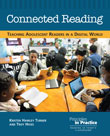Here’s another plug for an NCTE book.
As I re-evaluate my students’ writing experiences, I must
bring into focus an assignment that I invariably invest with so much ambition
and excitement—and from which many students invariably reap so much frustration:
the research paper. I know a galvanizing
research experience is possible: I have read about transformative project-based
learning assignments, about students spurred to action by inquiry into their
own communities. But the vision inevitably
gets lost in the execution, and I find myself as exhausted as those students whose
voice and passion are diminished by the form’s considerable technical demands.
Enter Connected Reading (Turner and Hicks, 2015), another NCTE “Principles in Practice” book,
which, in conjunction with Writing in the Dialogical Classroom (the topic of my last post), charts promising
routes to successful research-based writing. Whereas Writing in the Dialogical
Classroom maps an approach to habitual, reflective, and interactive
writing, Connected Reading describes tools
and practices that support the research process, just one part of a
comprehensive methodology for teaching digital texts.
Among the authors’ objectives is to tame the online
information crush. Their attempt to channel its “fire hydrant…deluge into
something more akin to a drinking fountain” succeeds in these areas (124):
- Reflecting on digital reading purposes and practices
- Using technology to make social connections around reading
- Using technology to research, annotate, and organize sources
Some
highlights –
Reflecting on digital reading purposes and
practices
The
authors recommend students evaluate their reading purposes and practices. Many
follow patterns of reading, passive and/or active, that they may not think
about.
The
book breaks down the digital reading process into three stages (paraphrased
from p. 51):
- Encounter the text in one of these ways: receive, stumble, surf, or search
- Engage with the text: read, cull and toss, classify, annotate, revise, share
- Evaluate the text: determine its value – assess interest level and purpose, find strengths and weaknesses, employ digital reading and sharing tools, prioritize reading over other claims on attention
Digital
texts are likewise classified:
- Linear – traditional print text (e.g., downloaded book) in digital form
- Non-linear text with hyperlinks - webpage with links
- Text with integrated media - webpage with visual, audio, and/or interactive media
- Text with response options – webpage that invites visitor participation in forums or communication with the author
Using technology to make social connections
around reading
“Training
wheels” for writing and sharing reading insights (before posting reviews to
Goodreads, Shelfari, etc):
- Youth Voices – book review writing templates,
- Youth Voices “Booktalk” channel – videos of student reviews
Reading
discussion in class:
- Literary circle wikis
- Read Actively – web-based e-reader (public domain) with teacher-authored reading questions, teacher links to related content, reading discussion threads, and student commentary
- Subtext – e-reader app with small-group reading discussion thread
- Diigo, Ponder, Curriculet – other e-reader programs
- Storify – to “synthesize reading” (122)
Online
sharing:
- Book reviews – Goodreads, Shelfari, BookTube, Quotev, Reddit
- Sharing/interpreting books with alternative media – Toondo comics, Digital Films animation, Scratch or Gamester Mechanic video game, Glogster, “augmented reality” book trailer
Using technology for research, annotation,
and organization
I
was excited to read about these tools for digitally marking up texts, compiling and organizing research sources, and increasing
students’ digital literacy:
Digital
Literacy Practices
- Give students a digital reading practices self-evaluation (see text p. 101)
- Explain the “filter bubble”; introduce search engines like DuckDuckGo and Blekko that do not compile user data
- Distinguish institutional websites from blogs: demonstrate using Technorati and Google Blog search engines
Research
Tools (apps and/or web-based)
- Citelighter – imports excerpts and bibliographic information from online sources; student comments on citation and exports everything to his or her document
- Diigo and Evernote – to save and annotate online text
- Flipboard, Pocket, Feedly, Clearly, Google Alerts – accumulate, compile, and/or store content on designated topics
Digital
annotation (apps and/or web-based)
- Google Docs or World Online/OneDrive – collaborative annotation of online excerpt/screenshot of print excerpt
- Skitch – photographing, briefly annotating print text
- Awesome screen shot – photographing text
- Screencast-o-Matic –verbal annotations of photographed text

No comments:
Post a Comment